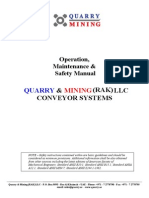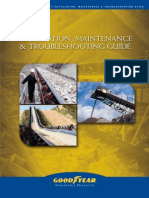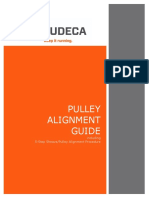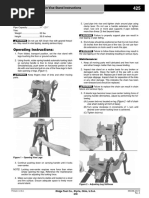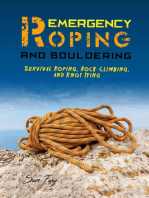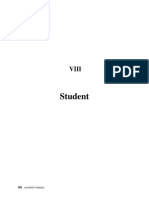SMP Conveyer Belt
SMP Conveyer Belt
Uploaded by
MELCO JITPLCopyright:
Available Formats
SMP Conveyer Belt
SMP Conveyer Belt
Uploaded by
MELCO JITPLCopyright
Available Formats
Share this document
Did you find this document useful?
Is this content inappropriate?
Copyright:
Available Formats
SMP Conveyer Belt
SMP Conveyer Belt
Uploaded by
MELCO JITPLCopyright:
Available Formats
SMP No: TL-SMP-35-01
Revision: 01
Effective: August 1, 2020
Supersedes: TL-SMP-35-00 (July 1, 2009)
Prepared by: Shyam Kumar Gujarathi
Power O&M
Approved by: K. Narayanan
Standard Maintenance Procedure for Conveyer Belt
TL-SMP-35-01
1. HAZARD IDENTIFICATION AND ASSESSMENT OF RISK & OPPORTUNITY (HIARO) NO:
2. SUMMARY OF THE OBJECTIVE
This document is created to provide the information to job execution team for carrying out maintenance
with best quality and safety.
3. RECOMMENDED SAFETY PPEs
S.N. Name Function
01 Safety Element Head Protection
02 Safety Shoes Foot Protection
03 Safety Goggles Eye protection
Protection from
04 Nose Mask
dust
05 Hand Gloves Hand Protection
06 Safety Belt Fall Protection
07 Ear plug Hearing Protection
Other specific PPE’s recommended in
08
HIARO to be used
4. FIELD CHECKS FOR SAFE MAINTENANCE
Work Permit No. :- Checks
S.N. Checks Reasons Yes No
1 Adequate Illumination Inadequate illumination causes accident
2 Proper Ventilation Easy breathing & relief from early fatigue
3 Any slippery agent on floor To avoid any accident/ incident
4 Cross checked LOTO & tag To avoid any un safe act
STANDARD MAINTENANCE PROCEDURE FOR CONEYER BELT
5. TROUBLE SHOOTING CAN HELP WHEN YOU SUSPECT A PROBLEM
Trouble Cause Correction
One or more idlers not at right angles to Advance the end of idler to which the belt
longitudinal centreline of belt. has shifted in the direction of belt travel.
Conveyor frame not lined up properly; or Stretch line along edge to determine how
Conveyor belt runs idler stand, or stands, not centred on belt. much out of line and correct.
to one side at a
particular pint on Sticking idlers. Replace or free idler
the conveyor.
Structure not level, belt tends to shift to low
Level Structure.
side
Improve maintenance. Install scrapers.
Build-up of material on idlers.
Splices not square. Re splice, cutting end square.
One section of
belting runs off to
one side all along Crooked belt caused by storage of If bow is in new belt, it may correct itself
the conveyor. telescoped rolls or one edge close to damp when belt becomes broken in; otherwise
ground or wall. replace it with a new section.
Conveyor belt runs
to one side for some Make changes in loading station and loading
Improper loading of belt.
distance along conditions so that it is centred properly.
conveyor line.
May be due to newness. If so, allow proper
break-in time. It will shorten break- in time if
belt is left loaded on off shift.
Tilt toughing idler forward a maximum of 2
degrees if conveyor is Never reversed in
direction.
Belt has erratic
action, following not Belt too stiff. Use self-aligning idlers. Use more trough
particular pattern. able belt.
Check alignment of pulley and adjacent
toughing idlers.
Remove material; provide better
housekeeping.
TL-SMP-35-01 Effective: August 1, 2020 Page 2 of 8
STANDARD MAINTENANCE PROCEDURE FOR CONEYER BELT
Adjust at right angle to frame.
Belt running off at Head pulley or toughing idlers approaching
head pulley. head pulley out of alignment. Adjust loading chute to properly centre the
load.
Build-up of material on return idlers.
Belt running off at Return rollers out of line. Unequal loading.
Increase tension or belt take-up device.
tail pulley.
Slippage between belt and drive pulley or
pulleys.
Lag drive pulleys, renew worn-out lagging.
Slippage between belt and drive pulley or Increase arc of contact drive pulley with
pulleys. (Cont.) snub pulley or use tandem drive.
Replace or free.
Excessive wear on
bottom side of belt. Install scrapers in front of tail pulley or
Sticking toughing idlers.
return belt.
Install belt-cleaning plows at head end and
Material ground between pulley and belt.
tail end.
Dirt, frozen or misaligned returns idlers. Clean, repair and align return idlers.
Excessive sag between toughing idlers Increase belt tension if too low.
causing load to move and shift on belt as it
passes over idlers. Reduce idler spacing.
Excessive wear on
Use rubber skirt material. Avoid use of old
carrying side of belt. Abrasive skirt boards.
belting.
Feed load on belt in same direction at same
Poor loading.
speed.
Reduce friction by placing frozen or worn-
out idlers.
Provide better maintenance.
Belt requires too Decrease tension by improving drive.
much tension 1. Lagging on drive pulleys.
Improper maintenance of toughing and 2. Increase arc of contact of drive pulley;
resulting in
return idlers. provide tandem drive.
excessive stretch in
belt. Increase speed, if possible, keeping shift
tonnage the same.
Reduce tonnage at slower speed.
TL-SMP-35-01 Effective: August 1, 2020 Page 3 of 8
STANDARD MAINTENANCE PROCEDURE FOR CONEYER BELT
Belt requires too Tighten screw take-up just enough to keep
much tension belt from slipping.
Improper maintenance of toughing and
resulting in On a gravity take-up reduce counterweight
return idlers.
excessive stretch in to minimum amount sufficient to keep belt
belt. from slipping.
Tension too high. Mildew. See Paragraph 1.
Use mildew inhibitor on belt.
Fasteners pull out Wrong type of fasteners or fasteners not Replace belt with proper fasteners that have
of belt. tight. the required strength.
Use vulcanized splices if feasible.
Improper starting. Use more acceleration steps in starting.
Short breaks in Impact of lumps falling on belt at loading
Use impact idlers.
carcass of belt station.
parallel to edge and
star breaks in Material trapped between belt and pulley. Install plows or scrapers ahead of pulley.
carcass.
Excessive noise or
Difference of ¼ inch diameters will cause
squealing in tandem Unequal diameters of drive pulley.
noise.
drive.
One or both pulleys loose on shaft.
Thumping noise in
Tighten pulleys. Change gears.
tandem drive. Gear out of mesh, improperly machined or
worn out.
Shaft and Hole tolerance chart
Over Dia
3 6 10 18 30 40 50 65 80 100 120 140 160 180 200 225 250 280
from
Up to
6 10 18 30 40 50 65 80 100 120 140 160 180 200 225 250 280 315
Incl.-MM
Shaft - 0 0 0 0 0 0 0 0 0 0
h7 -0.012 -0.015 -0.018 -0.021 -0.025 -0.03 -0.035 -0.04 -0.046 -0.052
0.012 0.015 0.018 0.021 0.025 0.03 0.035 0.04 0.046 0.052
Hole- H7
0 0 0 0 0 0 0 0 0 0
TL-SMP-35-01 Effective: August 1, 2020 Page 4 of 8
STANDARD MAINTENANCE PROCEDURE FOR CONEYER BELT
Bearing installation
S.N. Activities
1 Remove the old bearing with the help of bearing puller
Check shaft OD in bearing siting area with respect to bearing ID and make it require tolerance as per
2
chart
3 Check the levelling of rotor with master level and align using shim at plumber block base
4 Check top and bottom plumber block half contact with bearing outer race by blue matching.
4 Check the plumber block and maintain recommended interference.
Straight bearings above 50mm ID should be heated to
5 100°C for is ZZ category, 120°C for other bearings. No heating is required for taper bore bearing.
NOTE: Temperature above 120°C not allowed.
6 Bearing lock-nut tightness to be ensured as per clearance chart. Ensure proper surface of lock nut.
7 Install oil seal/ Dust seal/Gauge glass/ Grease nipple with proper care.
Mechanical seal installation
S.N. Activities
1 Clean the staffing box and shaft at seal location
2 Check and clean sleeve and remove all damaged 'O' rings and fix new rubber 'O' rings.
3 Lap the mating face and check the blue match
4 Fix the stationary mating part O-ring with seal flange.
5 Check and noted the max spring compression of seal externally
6 Fix the rotary part of seal on sleeve and set the adequate seal spring pressure.
7 Fix the seal cooling water line if applicable.
Coupling installation and alignment
S.N. Activities
1 Check the shaft OD at coupling siting area with respect to coupling ID.
2 Check the coupling bore and keyway and make it require tolerance.
3 Heat the coupling max140°C and fix the coupling without hammering.
5 Before alignment ensure drive and driven should not have any push or pull force by piping/cable
4 Check the soft foot error and correct it if required
Fix the two dial for axial and one for radial. Fix alignment clamps on prime mover also ensured clamp is
5
rigid enough. Dial gauge should move freely in full range of its scale.
Do axial and redial alignment with minimum number of shims. Take the TIR and make correction by the
6 shim as per calculation. TIR should be checked in all bolt tightened condition and recheck the reading
and confirm the same.
7 Remove the alignment clamp dial and fix the coupling and lubricant.
TL-SMP-35-01 Effective: August 1, 2020 Page 5 of 8
STANDARD MAINTENANCE PROCEDURE FOR CONEYER BELT
Maintenance Management Systems
Equipment Name: Conveyer Belt (Coal &lime etc.)
Types: M1- Checks, M2- Minor, M3- Major Maintenance
S. N. Maintenance Activities Yes No N/A Remarks
A M1, M2, M3- Common Checks
1 Is foundation frame sufficiently massive?
2 Check for any mechanical “looseness”.
3 Check static oil level drive gearbox
4 If grease lubricated, make sure not over packed.
5 Checking coupling bolts & spider.
6 Is the coupling guard securing?
7 Check the oil level of fluid coupling if applicable.
8 Check the cleanness of grease nipple for bearings
Check the water nozzle of dust suppression if
9
applicable.
Check the spray water pressure sufficiently
10
available, if applicable
11 Checking the belt joint condition
12 Check the belt edge condition has any damage.
13 Check and clean the pull card and belt sway switch
14 Check the skirt rubber condition
Check the Head, Tail, snub and bend pulley
15
condition.
16 Check the alignment of the belt
17 Check Motor drawing current
TL-SMP-35-01 Effective: August 1, 2020 Page 6 of 8
STANDARD MAINTENANCE PROCEDURE FOR CONEYER BELT
S.N. Maintenance Activities Checks Tools Yes No
B M2- Minor
1 Check all the joints condition Joint good condition Visual
2 Check the belt thickness Permissible Thick Vernier
3 Check the belt edge condition No damage Visual
4 Check the alignment of the Belt Centre Aligned Visual
5 Check the rollers condition Free Rotation Physical Check
Check the Head, Tail, Snub & Take up
6 Good Condition Visual
Drum Rubber
7 New Grease filling in Bearings. Adequate grease Grease Gun
8 Check the Pull cord function Properly Working Physical Check
9 Check the Drive alignment Permissible limit Dial gauge
10 Check the skirt rubber condition. Good Condition Visual
11 Check Vibration before & after work Vibration meter
12 Check Motor drawing current will be normal
C M3- Major Maintenance
1 Check all the joints condition Joint good condition Visual
2 Check the belt thickness Permissible Thick Venire
3 Check the belt edge condition No damage Visual
4 Check the alignment of the Belt Centre Aligned Visual
5 Check the rollers condition Free Rotation Physical Check
Check the Head, Tail, Snub & Take up
6 Good Condition Visual
Drum Rubber
7 New Grease filling in Bearings. Adequate grease Grease Gun
8 Check the Pull cord function Properly Working Physical Check
9 Check the Drive alignment Permissible limit Dial gauge
10 Check Shore hardness Permissible limit Durometer
11 Overhauling of Gear Box & Motor Fully Overhauled New seals
12 Check the Drive alignment Permissible limit Dial gauge
13 Check Vibration before & after work Vibration Meter
14 Check Motor drawing current Current will be normal
TL-SMP-35-01 Effective: August 1, 2020 Page 7 of 8
STANDARD MAINTENANCE PROCEDURE FOR CONEYER BELT
Name of Maintenance Engineer:
Department :
Contact No. :
Permit Details:
TL-SMP-35-01 Effective: August 1, 2020 Page 8 of 8
You might also like
- Conveyor Belt Alignment TroubleshootingDocument1 pageConveyor Belt Alignment TroubleshootingBosko Ginz JadibataNo ratings yet
- DODGE V Belt IOM PDFDocument8 pagesDODGE V Belt IOM PDFSupervisorNo ratings yet
- Granifrigor Prospekt Brochure enDocument6 pagesGranifrigor Prospekt Brochure enLê Tất TiếnNo ratings yet
- ConveyorPro Belt Common-MistakesDocument4 pagesConveyorPro Belt Common-MistakesAnthony AngNo ratings yet
- Belt Conveyor Troubleshooting: HGRS MASTER - MaintenanceDocument7 pagesBelt Conveyor Troubleshooting: HGRS MASTER - MaintenanceJerry HukyNo ratings yet
- Kreator Belt Install - 1490728195Document11 pagesKreator Belt Install - 1490728195Cassio Thome de FariaNo ratings yet
- Belt Alignment EbookDocument17 pagesBelt Alignment EbookDiego MonteNo ratings yet
- HW Installation Maintenance Troubleshooting Guide en PDFDocument48 pagesHW Installation Maintenance Troubleshooting Guide en PDFlukky prasetyoNo ratings yet
- 5.2 - Belt Replacement Instructions - EnglishDocument3 pages5.2 - Belt Replacement Instructions - Englishtedi mardetaNo ratings yet
- Belt Sway Control PDFDocument29 pagesBelt Sway Control PDFSrinivasa Rao Venkumahanthi50% (2)
- Troubleshooting ConveyorDocument7 pagesTroubleshooting Conveyorsapu11jagat5855No ratings yet
- Conveyor Belt Tracking GuideDocument3 pagesConveyor Belt Tracking GuidebruthenbergNo ratings yet
- Trouble Shooting On Conveyor BeltingsDocument17 pagesTrouble Shooting On Conveyor BeltingsVimal Bhansali100% (1)
- Conveyor Belt Maintenance & Trouble Shooting ManualDocument48 pagesConveyor Belt Maintenance & Trouble Shooting ManualMichael D. Torres100% (1)
- ConveyorDocument14 pagesConveyorchenkok_90No ratings yet
- Conveyor Belt Common Problem Trouble Shooting GuideDocument10 pagesConveyor Belt Common Problem Trouble Shooting GuideifoodNo ratings yet
- 2006-09 - Conveyor Belt Basic Rules and Procedures For Tracking and TrainingDocument7 pages2006-09 - Conveyor Belt Basic Rules and Procedures For Tracking and TrainingZoebair0% (1)
- Drive Belt Troubleshooting GuideDocument12 pagesDrive Belt Troubleshooting GuideQuang Nguyen HuynhNo ratings yet
- Filatex Project - O & M MANUAL - VOLUME I OF IIDocument48 pagesFilatex Project - O & M MANUAL - VOLUME I OF IID.V.S.S Ram PrasadNo ratings yet
- Belt Failure AnalysisDocument4 pagesBelt Failure AnalysisTamer EmamNo ratings yet
- Instructions Trauma StrapDocument1 pageInstructions Trauma StrapandrewhwNo ratings yet
- Conveyor Belt Maintenance Manual 2010 PDFDocument46 pagesConveyor Belt Maintenance Manual 2010 PDFkhuong_uno100% (3)
- Tabla Tension Correas Gates PDFDocument4 pagesTabla Tension Correas Gates PDFHarold BurgosNo ratings yet
- Pulley Alignment ProceduDocument9 pagesPulley Alignment ProceduJosh Watts100% (2)
- Magic Carpet Ride EnglishDocument4 pagesMagic Carpet Ride EnglishgvengveNo ratings yet
- Derailleur AdjustmentDocument19 pagesDerailleur AdjustmentpitbullNo ratings yet
- Guide Yarway Graphlock 98 Packing Set en 10128576Document2 pagesGuide Yarway Graphlock 98 Packing Set en 10128576jfresgo82No ratings yet
- Lead Seal Casing Patches: Instruction Manual 6400Document9 pagesLead Seal Casing Patches: Instruction Manual 6400Ragui StephanosNo ratings yet
- Training of Conveyor BeltDocument4 pagesTraining of Conveyor BeltAk AbdulwahabNo ratings yet
- Load Binder Warnings and Application Instructions Instructions - Lever Type Load BindersDocument1 pageLoad Binder Warnings and Application Instructions Instructions - Lever Type Load BindersRusdi BaccoNo ratings yet
- GBH TroubleshootDocument4 pagesGBH Troubleshootalaynnastaabx786No ratings yet
- Bucket Elevator Chain InstallationDocument27 pagesBucket Elevator Chain Installationm s sankar raoNo ratings yet
- BR09023E CapsHoistDocument8 pagesBR09023E CapsHoisttdzeienNo ratings yet
- Steering, Suspension, Wheels and Tires: Service InformationDocument43 pagesSteering, Suspension, Wheels and Tires: Service Informationfaiq amhar pamungkasNo ratings yet
- Instruction Installation Manual Tensioner enDocument7 pagesInstruction Installation Manual Tensioner enhndapipNo ratings yet
- Seam 1 Module 5Document46 pagesSeam 1 Module 5Rene Jan HilberoNo ratings yet
- VDiff Sport Climbing Basics SampleDocument13 pagesVDiff Sport Climbing Basics SampleVycheslav PanevskiiNo ratings yet
- 999-998-423 - 425 InstructionsDocument4 pages999-998-423 - 425 InstructionsKimba WorthNo ratings yet
- Belt Conveyor Idler: Read These Instructions Carefully Before Starting InstallationDocument8 pagesBelt Conveyor Idler: Read These Instructions Carefully Before Starting InstallationKenji LacambraNo ratings yet
- Chain SprocketDocument3 pagesChain SprocketmarcalasanNo ratings yet
- Conveyor SpecsDocument8 pagesConveyor SpecsPrashant TankNo ratings yet
- Operating & Servicing Instructions For: WarningDocument4 pagesOperating & Servicing Instructions For: WarningCopyMaster2No ratings yet
- Instructions For The Safe Use Of: ShacklesDocument2 pagesInstructions For The Safe Use Of: ShacklesAmeerUlHaqNo ratings yet
- Technician Tips: Eccentric Locking Collar InstallationDocument1 pageTechnician Tips: Eccentric Locking Collar InstallationJames MurrayNo ratings yet
- Instructions For Safe Use ShacklesDocument2 pagesInstructions For Safe Use ShacklesNickNo ratings yet
- Care of Belting 02Document9 pagesCare of Belting 02jonodo89No ratings yet
- V-Belt Drive Failure AnalysisDocument1 pageV-Belt Drive Failure AnalysisMuhammad afzal100% (1)
- Presentacion 89Document1 pagePresentacion 89darwindt0816No ratings yet
- Trouble-Shooting Five Common Belt Conveyor Buildup ProblemsDocument2 pagesTrouble-Shooting Five Common Belt Conveyor Buildup ProblemsTamal Tanu RoyNo ratings yet
- WWW Petzl Com INT en Sport Multi-Pitch-Rappelling-With-A-Single-RopeDocument1 pageWWW Petzl Com INT en Sport Multi-Pitch-Rappelling-With-A-Single-Ropeseek86okNo ratings yet
- Road 2x Front Derailleur Installation VerFD002001Document21 pagesRoad 2x Front Derailleur Installation VerFD002001namita.sridasNo ratings yet
- Chain Installation: Safety PrecautionsDocument16 pagesChain Installation: Safety PrecautionsAlejandro RodriguezNo ratings yet
- Nukeproof Top Guide Top Guide With BashDocument1 pageNukeproof Top Guide Top Guide With BashNicky KiloNo ratings yet
- What Are The Advantages and Disadvantages of Belts Compared To Other Forms of Power Transmission?Document2 pagesWhat Are The Advantages and Disadvantages of Belts Compared To Other Forms of Power Transmission?Rex SabersonNo ratings yet
- CB How To Use CB ProperlyDocument25 pagesCB How To Use CB ProperlyBraydi VeraNo ratings yet
- Rigging GuidelinesDocument14 pagesRigging GuidelinesMalik AtikNo ratings yet
- Care of Belting Rev 01Document10 pagesCare of Belting Rev 01jonodo89No ratings yet
- The Instant Handbook of Boat Handling, Navigation, and Seamanship: A Quick-Reference Guide for Sail and PowerFrom EverandThe Instant Handbook of Boat Handling, Navigation, and Seamanship: A Quick-Reference Guide for Sail and PowerRating: 5 out of 5 stars5/5 (1)
- Emergency Roping and Bouldering: Survival Roping, Rock-Climbing, and Knot Tying: Survival FitnessFrom EverandEmergency Roping and Bouldering: Survival Roping, Rock-Climbing, and Knot Tying: Survival FitnessNo ratings yet
- HIRA - Insulation WorkDocument3 pagesHIRA - Insulation WorkMELCO JITPLNo ratings yet
- HIRA - Hopper SealingDocument3 pagesHIRA - Hopper SealingMELCO JITPLNo ratings yet
- HIRA - RT & SR WorkDocument9 pagesHIRA - RT & SR WorkMELCO JITPLNo ratings yet
- BTG AlarmDocument7 pagesBTG AlarmMELCO JITPLNo ratings yet
- HIRA - Refractory WorkDocument3 pagesHIRA - Refractory WorkMELCO JITPL67% (3)
- WBDocument2 pagesWBMELCO JITPLNo ratings yet
- Bik VaccumDocument2 pagesBik VaccumMELCO JITPLNo ratings yet
- Description Electr. Drawing 5800029 - BHELDocument2 pagesDescription Electr. Drawing 5800029 - BHELMELCO JITPLNo ratings yet
- Block Diagram Automatic Remote Mode - BHELDocument1 pageBlock Diagram Automatic Remote Mode - BHELMELCO JITPLNo ratings yet
- Block Diagram Local Mode HMQ-F - 250-2000 5800029 - BHELDocument1 pageBlock Diagram Local Mode HMQ-F - 250-2000 5800029 - BHELMELCO JITPLNo ratings yet
- S7-5800029-02 - Doku - en - BHEL BoilerDocument54 pagesS7-5800029-02 - Doku - en - BHEL BoilerMELCO JITPLNo ratings yet
- Clover-Mini3-QuickStartGuide-v7-webDocument10 pagesClover-Mini3-QuickStartGuide-v7-webholaNo ratings yet
- TRICARE ID CardDocument2 pagesTRICARE ID CardDixie PettitNo ratings yet
- Practice Exercises Unit 8Document4 pagesPractice Exercises Unit 8Sheryll Joan SolanoNo ratings yet
- KriDocument8 pagesKriRhea GuptaNo ratings yet
- Syed's Resume (2)Document1 pageSyed's Resume (2)syedjibran245No ratings yet
- Fortune Retreat BrochureDocument29 pagesFortune Retreat Brochureprajwal.6989No ratings yet
- P1377 - EvpDocument3 pagesP1377 - Evpjames riceNo ratings yet
- 09 Maret 2019-Daftar Peserta Progress Test Periode Maret-April (Sesi 1) PDFDocument5 pages09 Maret 2019-Daftar Peserta Progress Test Periode Maret-April (Sesi 1) PDFRaditya TaslimNo ratings yet
- Language Maintenance and ShiftDocument2 pagesLanguage Maintenance and ShiftArianti SaputraNo ratings yet
- Littlefield v. Fresno Superior Court Clerk&apos S Office Et Al - Document No. 6Document4 pagesLittlefield v. Fresno Superior Court Clerk&apos S Office Et Al - Document No. 6Justia.comNo ratings yet
- JAVA Lab PracticesDocument7 pagesJAVA Lab PracticesSubhajit GhoshNo ratings yet
- Drug Safety ReviewsDocument5 pagesDrug Safety ReviewsToronto StarNo ratings yet
- Karakter Anak Usia Dini Yang Tinggal Di Daerah Pesisir PantaiDocument12 pagesKarakter Anak Usia Dini Yang Tinggal Di Daerah Pesisir PantaiMoh. Ibnu UbaidillahNo ratings yet
- Comendador V de Villa - Case Digest PDFDocument11 pagesComendador V de Villa - Case Digest PDFPeace Marie PananginNo ratings yet
- Student ManualDocument65 pagesStudent ManualFranklin TamayoNo ratings yet
- Break Even Analysis y Training MatrixDocument5 pagesBreak Even Analysis y Training Matrixgina garciaNo ratings yet
- NALADIYARDocument55 pagesNALADIYARDineshNo ratings yet
- Alea EvangeliiDocument2 pagesAlea EvangeliiEvander M. NovellNo ratings yet
- Cep - Mp-IDocument2 pagesCep - Mp-Iwww.sadafzahra543No ratings yet
- Drilling and Blasting Designs For Parallel Hole Cut and V Cut Method in Excavation of Underground Coal Mine GalleriesDocument18 pagesDrilling and Blasting Designs For Parallel Hole Cut and V Cut Method in Excavation of Underground Coal Mine GalleriesAuã KiahlaNo ratings yet
- A Bibliometric Review of Green Building ResearchDocument16 pagesA Bibliometric Review of Green Building Researchazizul wahidNo ratings yet
- Chapter One: 1.1 Background of StudyDocument2 pagesChapter One: 1.1 Background of StudyjonathanNo ratings yet
- 3599Document6 pages3599fadosaniNo ratings yet
- Confirm RobotsDocument340 pagesConfirm RobotsGOD'S GRACENo ratings yet
- Worksheet Live WorksheetsDocument1 pageWorksheet Live WorksheetsdarwinsguamanNo ratings yet
- CIR Vs Norton and Harrison (1964)Document8 pagesCIR Vs Norton and Harrison (1964)Joshua DulceNo ratings yet
- 2ms Third Term TestDocument2 pages2ms Third Term TestNesrine AridNo ratings yet
- Sets WorksheetDocument5 pagesSets WorksheetErnesto AcostaNo ratings yet
- Cluster L&D Manager of Swissotel MakkahDocument4 pagesCluster L&D Manager of Swissotel MakkahReda ShakerNo ratings yet














